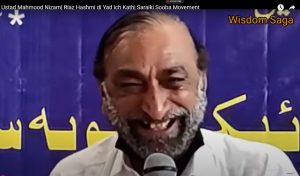ORDERLY AND PEACEFUL BUT PROBLEMS WITH RESULTS MANAGEMENT, FAFEN REPORT ON GB ELECTIONS2020
FAFEN’s Preliminary Report on GB Election Observation
The people of Gilgit-Baltistan went to the polls on November 15, 2020 to elect their representatives for 231 seats of the
Gilgit-Baltistan Assembly. Braving harsh weather conditions in some areas and low temperatures in others, a high number
of men and women in diverse regions cradled by the world’s highest mountain ranges turned out to vote in the third
consecutive general elections to the Assembly, expressing their support for democracy and political stability.
Coming on the heels of a constitutional amendment to grant Gilgit-Baltistan the status of provisional province, the
impressive participation of people in the November 15 election was a reinforcement of their expression of the desire to
be part of the Pakistani federation. More than 60 percent of registered voters turned out to vote, according to provisional
results of 20 constituencies that have been received so far.
Although required by the law, the Returning Officers (ROs) did not provide gender disaggregated turnout data in seven
of the 20 constituencies (one-third or 35 percent) for which the provisional results are available. In the other 13 where
the ROs did provide this information on Form 47 (Provisional Consolidated Results of the Statement of the Count) female
voter turnout was 53.8 percent as compared to 59.6 percent of male voters. Gender disaggregated turnout data is not
available for GBA-8 Skardu-II, GBA-9 Skardu-III, GBA-12 Shigar, GBA-13 Astore-I, GBA-15 Diamir-I, GBA-17 DiamirIII, which may prevent the Election Commission of Gilgit-Baltistan (ECGB) from implementing the provisions of Section 9(1)
of the Elections Act, 2017 requiring re-polling in one or more polling stations or the entire constituency if female turnout
is less than 10 percent of the total votes polled in that constituency. Although observers of the Free and Fair Election
Network (FAFEN) did not report any restriction to women’s voting, female turnout remained significantly low in at least
two constituencies, namely GBA-16 Diamir-II and GBA-18 Diamir-IV. This may have been due to cultural factors that
need to be addressed through long-term engagement with communities by ECGB, political parties and civil society
organizations. In addition, the ECGB may take special measures for women voter education and registration as required
by Sections 12 (c) and 47 of the Elections Act, 2017.
A vibrant and competitive election campaign by all major parties and independent candidates turned intense and heated
towards the end over the controversy of federal minsters running election campaigns in violation of legal limits. As many
as 320 candidates including four women – 127 representing 16 political parties and 200 independent candidates –
were contesting in 23 constituencies. Nevertheless, the election day remained largely peaceful with no major incidents of
violence reported from anywhere in the region throughout the day. However, a few incidents of protests and violence
were reported from some constituencies of Gilgit, Ghanche, Ghizer and Diamer due to the delay in the release of results.
The election day was generally orderly, with voting and counting processes at the polling stations conducted mostly
according to the law and prescribed rules, though the legally mandatory provision of Form 45 (the Result of the Count)
to polling agents was reported to have not been fully ensured by the presiding officers. Election officials at polling
stations appeared well-versed with the provisions of the Elections Act, 2017, which Gilgit-Baltistan had adopted for these
elections. Impressively, the ECGB mostly ensured the enforcement of the law’s ban against campaigning and canvassing on election day. Fewer than one-third of the observed polling stations had camps set up by political parties and
independent candidates for wooing voters.
However, not all polling stations completely followed the prescribed procedure. Observers deployed by FAFEN reported
an average of around three illegalities or irregularities per polling station. These included breach of the secrecy of the
vote, stamping of ballots by others on behalf of voters, and voters registered at the polling stations turned away for
various reasons despite having their National Identity Cards (NICs). Such issues could have been avoided with more
diligent enforcement by ECGB. In addition, instances of allocation of more than the legally prescribed number of voters
per polling booth led to over-crowding and disorder at some polling stations.
Similarly, the ECGB did not consistently ensure the provision of Form 45 (the Result of the Count) and Form 46 (the Ballot
Paper Account) to all polling agents present at the polling stations during the vote counting process, which would have
helped to enhance the integrity of the election results management. The problem was largely due to insufficient numbers
of these forms available at the polling stations. Resultantly, the presiding officers had to issue polling stations’ results to
the polling agents on plain papers under their stamps and signatures, the legality of which has yet to be established.
The voting and counting processes were mostly transparent, with FAFEN observers reporting the presence of polling
agents of major political parties and independent candidates in most polling stations. However, instances of polling agents
seated at a place from where they could not observe the voting process was reported from six constituencies. More
serious are reports that candidates and their agents were barred from ROs’ offices during the preparation of the
preliminary results in at least three constituencies, and delays in the release of provisional results on Form-47 (Provisional
Consolidated Statement of Results of the Count) in more than 10 constituencies. These problems shaped the political
discourse on an otherwise orderly and peaceful electoral exercise conducted according to the law, which requires
finalization of provisional results by 2:00 am on the day following the polling. These issues also caused major political
contenders to question the credibility of the outcome and to raise allegations of electoral fraud. Many of these issues,
however, could have been addressed by the Chief Election Commissioner (CEC) using his clearly defined powers under
Sections 4(3)2, 8(b)3, 9(1)4 and 95(6)5 of the Elections Act, 2017 in order to strengthen the confidence of electoral
contenders in the integrity of the process.
FAFEN observers faced almost no restrictions to their observation of the voting process at the start of the day, but
encountered challenges particularly in Skardu for the observation of the counting process. Major contending parties
promptly called upon the ECGB to ensure that independent observers were allowed to view the counting processes, as
permitted by law, as a perquisite for the integrity of the election outcome. Timely directions issued by the ECGB to the
relevant District Returning Officers (DROs) ensured the presence of FAFEN observes at the counting process in most
locations. Presiding officers disallowed FAFEN observers from observing the vote count at the polling stations in fewer
than 10 instances.
Media and other observer groups were also allowed to cover and observe the proceedings on election day, with no
incidences of restrictions reported. However, the ECGB could have released election results progressively as they were
received from the polling stations to ensure that the media reported accurate official results promptly, instead of using a
parallel system to gather information and report unofficial and potentially unreliable results. Incoherence in tallies of vote count by media and at the offices of the ROs created confusions that may be clarified after the release of official
results as well as publication of all Forms 45 and 46 within 14 days of the day of the poll on the ECGB website as
required by Section 95(10) of the Elections Act, 2017.
FAFEN trained and deployed 529 non-partisan observers, including 496 election day observes and 33 long-term
observers (LTOs). Almost 30 percent of FAFEN observers were women. This preliminary report is based on the summary
observation of 436 polling stations observed in 23 constituencies, more than 37 percent of 1,137 polling stations – 385
male, 386 female and 402 combined.










اے وی پڑھو
🛑Daily Swail Baithak| Saraiki Wasson ich Flood 2025| Daily Swail
اُچ ڈھاندی ڈیکھ تے چھوراں وی وٹے مارے ہن۔۔۔|شہزاد عرفان
ریاض ہاشمی دی یاد اچ کٹھ: استاد محمود نظامی دے سرائیکی موومنٹ بارے وچار